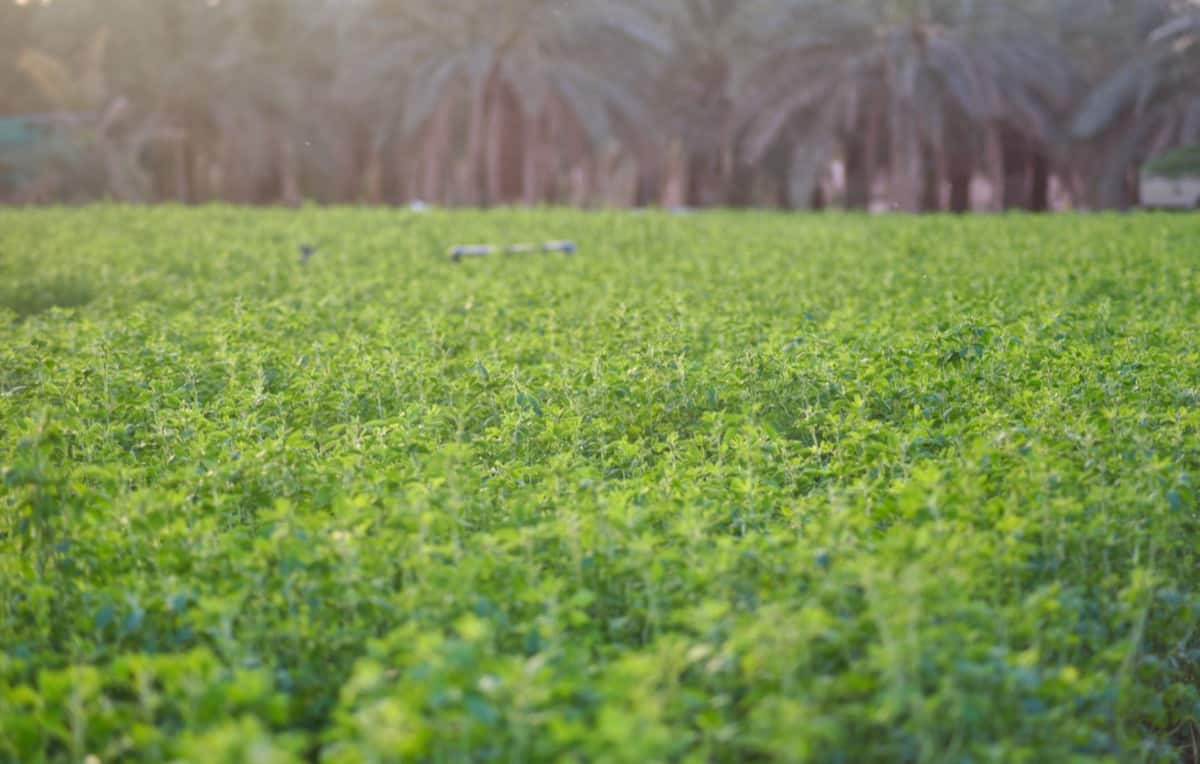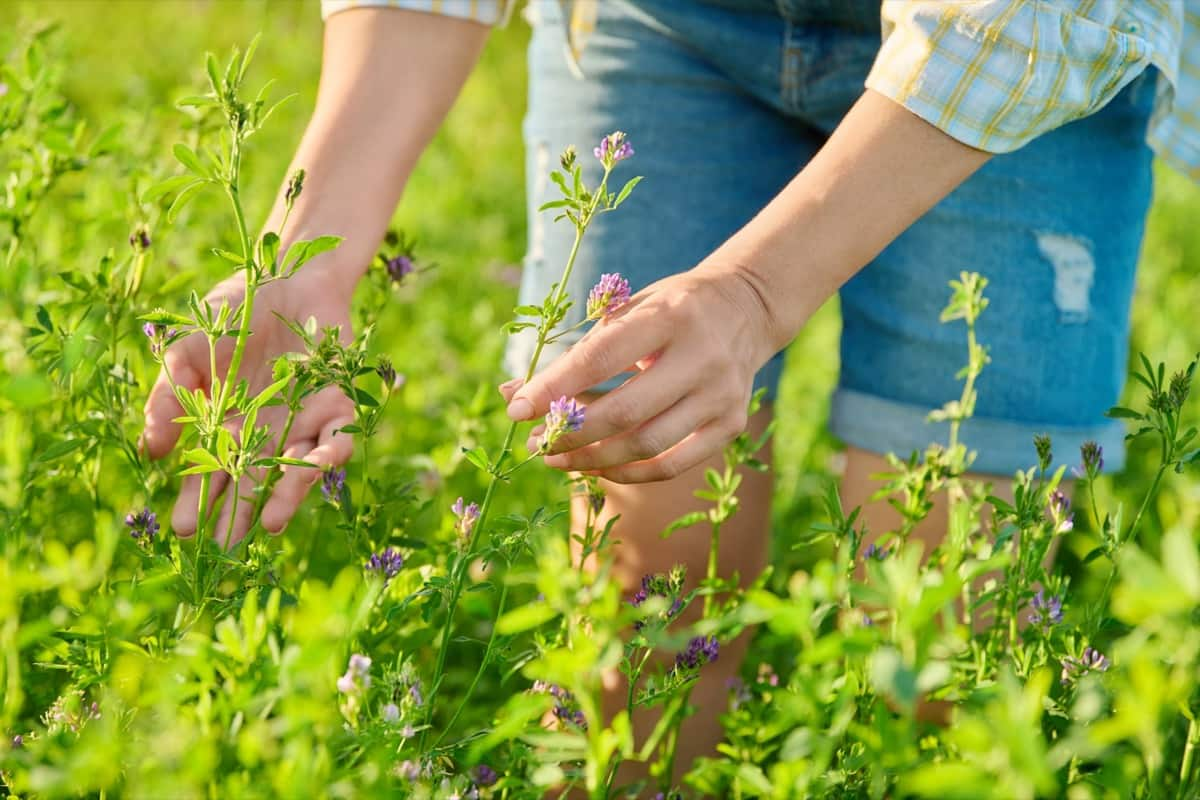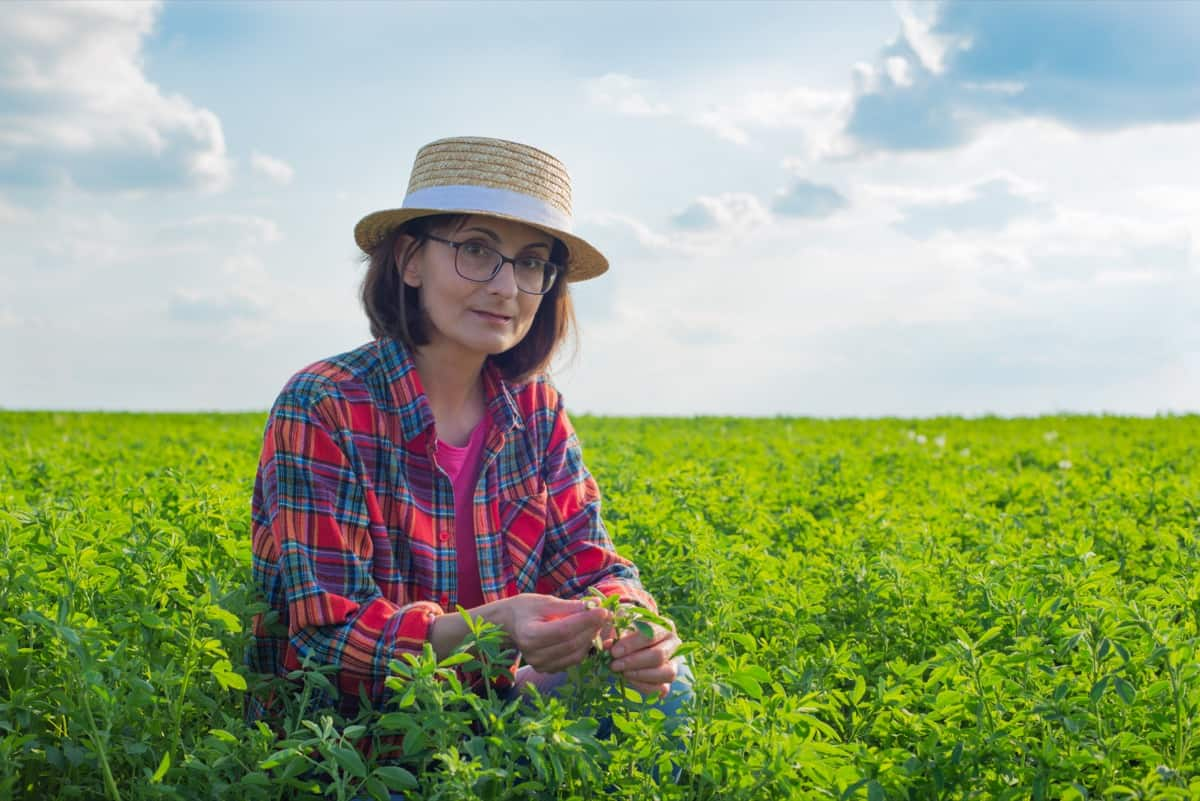Alfalfa is a high-yielding, nutrient-rich forage crop widely cultivated across the United States, primarily for feeding dairy cows, beef cattle, and other livestock. The crop is known for its deep root system, which enables it to withstand droughts and access nutrients deep within the soil. This makes alfalfa farming a profitable and sustainable choice for farmers. Below we learn how to start alfalfa farming in the USA, including how to grow alfalfa seeds, ideal growing temperatures and zones, and planting alfalfa by hand.

How to Start Alfalfa Farming in the USA
Right Location and Soil
The first step in starting an alfalfa farm is to select the right location. Alfalfa thrives in well-drained, fertile soils with a pH between 6.0 and 7.5. It is crucial to test your soil’s pH, nutrient levels, and drainage capabilities before planting. Lime can be used to increase the pH of the soil, while sulphur can be used to decrease it. Choose a spot that gets enough of sun yet is protected from wind for optimal alfafa development.
Right Alfalfa Variety
Many alfalfa varieties are available, each with its specific growth characteristics, disease resistance, and yield potential. When choosing a variety, consider your region’s climate, disease prevalence, and intended use of the crop. Consult with local agricultural extension agents or other farmers in your area to determine the best alfalfa varieties for your specific needs.
Preparing the Seedbed
A well-prepared seedbed is crucial for a successful alfalfa establishment. Starting at a depth of 6-8 inches, till the soil to break up any big clumps and remove any trash. Organic materials, such as compost or manure, may be worked into the soil to enhance its structure and fertility, although this is not always necessary. To encourage strong root development, create a firm seedbed by compacting the soil using a roller.
Planting
There are several methods to plant alfalfa seeds, including broadcasting, drilling, and planting by hand. To plant alfalfa by hand, follow these steps:
- Measure the recommended seeding rate for your chosen alfalfa variety, typically between 15 and 20 pounds per acre.
- Divide the seeds into two equal portions.
- Walk the field in a north-south direction, evenly broadcasting half of the seeds as you go.
- Repeat the process, walking east-west and broadcasting the remaining seeds to ensure uniform coverage.
- Use a rake or harrow to lightly cover the seeds with 1/4 to 1/2 inch of soil, ensuring that they maintain good contact with the soil for optimal germination.
Growing Temperature
Alfalfa germination requires soil temperatures between 40°F and 70°F, with optimal germination occurring at 68°F. The crop is relatively hardy and can tolerate light frosts. However, prolonged exposure to temperatures below 15°F may damage the plants. Throughout the growing season, alfalfa prefers average daytime temperatures between 70°F and 85°F. Monitor temperature conditions and adjust irrigation and other management practices accordingly to ensure optimal growth.
In case you missed it: How to Start Strawberry Farming in the USA: A Step-By-Step Production Guide

Growing Zones
In the United States, alfalfa can be grown in various climates, spanning USDA Hardiness Zones 4 through 9. Alfalfa is most commonly grown in the Midwest, Great Plains, and Western regions, where the climate is well-suited for its growth. However, with proper management and variety selection, alfalfa farming can be successful in many other areas of the country.
Irrigation and Water Management
Alfalfa’s extensive root system helps it to get water even in the lowest parts of the soil. However, proper irrigation is essential to maximize crop yield and quality, particularly during the establishment phase and periods of drought. Alfalfa needs between 1 and 2 inches of water each week, depending on the climate and the soil. Utilize drip irrigation or a center pivot system to deliver water efficiently and uniformly to the crop.
Fertilization and Nutrient Management
Alfalfa has a high demand for nutrients, particularly nitrogen, phosphorus, and potassium. Alfalfa can fix its own nitrogen from the atmosphere, but phosphorus and potassium must be supplied through fertilization. Apply a balanced fertilizer according to the soil test results and your alfalfa variety’s specific nutrient requirements. Monitor plant growth and adjust your fertilization strategy as needed throughout the growing season.
Weed, Pest, and Diseases
Effective weed, pest, and disease management is critical for a successful alfalfa crop. Start with a clean seedbed and use certified weed-free seeds to minimize the risk of weed infestations. Implement an integrated pest management (IPM) approach that includes monitoring for pests and diseases, maintaining optimal growing conditions, and utilizing biological, cultural, and chemical control methods as necessary.
Harvesting and Storage
Alfalfa is typically harvested three to five times yearly, depending on the variety and growing conditions. Harvesting should occur when the alfalfa reaches early bloom, which usually coincides with peak forage quality. Use a mower-conditioner to cut the alfalfa, allowing it to dry to the appropriate moisture content (15-18%) before baling. Store baled alfalfa in a dry, well-ventilated area to prevent mold and spoilage.
Monitoring Plant Growth
Regularly inspect your alfalfa fields to assess plant growth, stand density, and overall crop health. Thin or sparse stands may indicate issues with seed germination, weed competition, or soil fertility. Address any issues promptly to maintain optimal growth and yield potential. Use a plant density of 20 to 30 plants per square foot as a benchmark for a healthy, productive alfalfa stand.
Frost Management
Frost can damage alfalfa, particularly during early growth or when the crop is near harvest. To minimize the impact of frost, avoid planting alfalfa too early in the season and monitor weather forecasts closely. If frost is expected, consider delaying harvest or adjusting irrigation schedules to protect the crop.
Rotational Grazing and Soil Health
Incorporating rotational grazing into your alfalfa farming operation can help maintain soil health and prevent erosion. You can reduce soil compaction by periodically moving livestock to different field areas, encourage plant regrowth, and maintain a more consistent forage supply. Additionally, rotational grazing can help break pest and disease cycles, reducing the need for chemical interventions.
In case you missed it: How to Start Grapes Farming in the USA: A Step-by-Step Production Guide

Conclusion
Alfalfa farming in the USA offers a promising and sustainable agricultural venture. By carefully selecting the right location, variety, and management practices, you can establish a thriving alfalfa farm that provides high-quality forage for livestock and contributes to overall soil health. With diligence, patience, and attention to detail, you can enjoy the many benefits of alfalfa farming and contribute to a more sustainable agricultural landscape.
- Feed Your Flock for Less: Top 10 Tips to Save on Chicken Feed
- Ultimate Guide to Ossabaw Island Hog: Breeding, Raising, Diet, and Care
- Hatching Answers: The Top 10 Reasons Your Chickens Aren’t Laying Eggs
- Eggs and Economics: Breaking Down the Cost of Raising Backyard Chickens
- Defend Your Greens: Proven Methods to Keep Iguanas Out of Your Garden
- Ultimate Guide to Cinnamon Queen Chicken: A Comprehensive Guide for Beginners
- Ultimate Guide to California Tan Chicken: Breeding, Raising, Diet, Egg-Production and Care
- Ultimate Guide to Marsh Daisy Chicken: Breeding, Raising, Diet, and Care
- 10 Types of Chicken Farming Businesses You Can Start for Profits